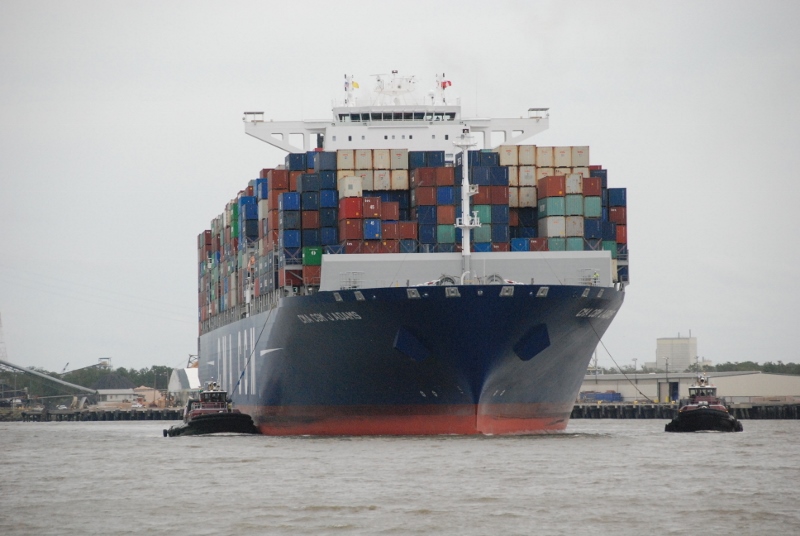A year after their first arrival, the massive CMA CGM containerships can still draw a crowd to the River Street park in Savannah, Ga.
On Oct. 25 it was the CMA CGM John Adams, escorted by the Moran Towing Corporation tugs Cooper Moran, Laura K. Moran and Edward J. Moran, easing the 1,200’x158’, 14,140-TEU ship up the fast-flowing Savannah River.
The ship’s horn echoed off the brick walls of the historic riverfront, where sail and steam once carried cotton exports. The Adams’ sister ship, the CMA CGM Theodore Roosevelt, called here for the first time in September 2017, a few days before it passed under the newly raised Bayonne Bridge to become the biggest containership to ever reach Port Newark, N.J.

The 14,000 TEU CMA CGM vessel Theodore Roosevelt sails past historic River Street to the Port of Savannah in September 2017. Georgia Ports Authority photo/Stephen Morton.
The U.S. East Coast ports have been in a long-term hustle to keep up with bigger ships and demand for new efficiencies in international trade. The Georgia Ports Authority is still one of the smaller contenders behind older hubs like New York/New Jersey and Norfolk, Va., but it is growing volume and adding capacity quickly.
In September the Port of Savannah saw a 12% increase in containerized trade, while roll-on/roll-off trade was up 37.6% at the Port of Brunswick. Port officials said Savannah has seen 23 months of consecutive growth – despite jitters over the potential for trade war between the U.S., China and other nations.
“From exports to imports, autos and machinery units to containerized goods, our ports are firing on all cylinders,” said GPA Board Chairman Jimmy Allgood in announcing the results Oct. 17. “Our success is the result of always looking out on the horizon for what’s coming next.”
Griff Lynch, the GPA executive director, has said the growing U.S. economy and Savannah’s rail connections are big factors in the growth.

Spectators gathered on River Street in Savannah, Ga., to greet the crew of the CMA CGM John Adams when she arrived Oct. 25, 2018. Kirk Moore photo.
Cargo moving by rail outpaces Savannah’s overall TEU volume, with containers moving by rail expanding by 35% in September and 30% over the course of the year. Port officials are making a bigger bet on rail, in September approving $92 million in improvements including 23 miles of track, switching equipment and container cranes.
When complete in 2020 the “Mason Mega Rail Terminal,” as it is called, will accommodate trains up to 10,000’ long and making direct serve more cost-effective for Norfolk Southern and CSX.
There is a lot of room for growth on the ground. The port authority’s 10-year plan is to expand terminal capacity from 5.5 million TEUs to 8 million.
“We’re preparing to redefine the Port of Savannah as not simply the load center for the Southeastern U.S., but as the port of choice for major inland markets east of the Mississippi River,” Lynch said in a Sept. 12 presentation to Georgia political and business leaders. Since 2011 Savannah’s container volume has grown by 45% and the Corps of Engineers is halfway through its harbor deepening project.
At some point, the Georgia Ports Authority may even consider following in the steps of the Port Authority of New York/New Jersey, when it spent $1.7 billion to raise the Bayonne Bridge from 151’ to 215’ the accommodate the new generation of neo-Panamax freighters. The Tallmadge Memorial Bridge that carries Route 17 over the Savannah River has an air draft of 185’, and it is possible the port could one day see calls from even bigger ships of 19,000-TEU capacity.





